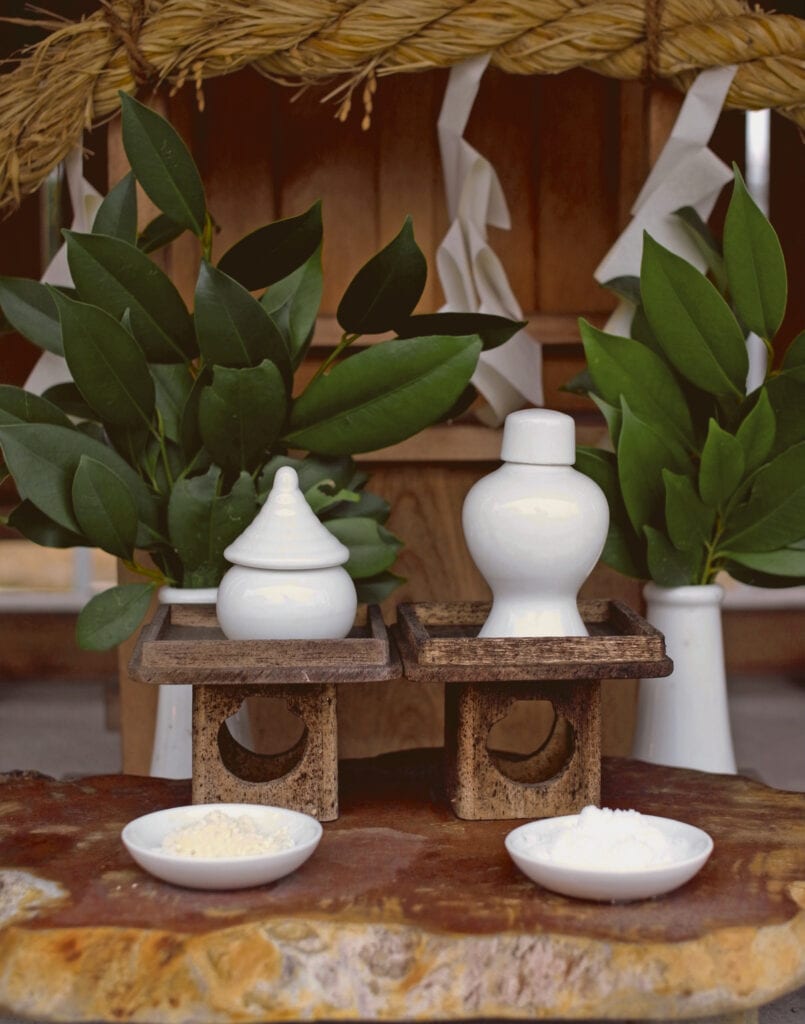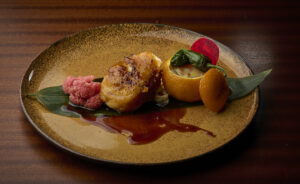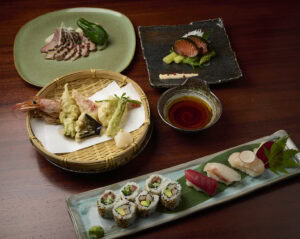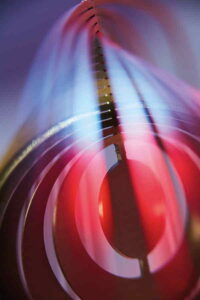Origin and meaning of the word "sake
One of Japan's oldest surviving history books is the Kojiki (古事記), which roughly stands for "Record of Ancient Events." In this book, which supposedly dates back to 712, sake was called "ki" or "miki." How did the word "sake" evolve from this?
One theory is that the prefix "sa" was added to the old name "ki".
Another assessment cites that sake was once called "Sakae-mizu" (栄え水, "splendid water") because people felt good after drinking it.
In the Japanese language, sake is written with the kanji (漢字, Chinese character). The character "酒" is composed of two components, which are said to have originated as pictograms: a liquid on the left and a jug on the right. The same characters "酉" can be found as a component of the word medicine. Sake for health? Remarkable!
There was a time when sake was the only alcoholic beverage to be found in Japan. At that time, of course, sake meant the rice wine that Europeans now know as sake. Today, however, with beer, wine, whiskey, and countless other alcoholic beverages available, the word "sake" is a common term used by the Japanese to refer to any alcoholic beverage. To distinguish sake from other alcoholic beverages, the Japanese usually refer to it as "Nihon-shu" (日本酒), which translates as. means "Japanese National Drink.
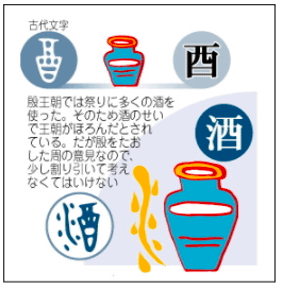
The correct German translation for sake is due to its Manufacturing process hard to find.
This is because the brewing process makes sake production most comparable to beer. The name rice beer would be somewhat misleading due to the alcohol content and mostly not bubbly state.
From the aroma sake would be most comparable with the European wine - therefore one calls sake also gladly rice wine.
At the same time, the word "sake" in Japan from the character actually just means "alcoholic beverage" and in Japan the sake we are talking about here is often called "Nihon-Shu". So, as so often in the Japanese language, it often depends on the context and things are not so easy to explain and translate - their uniqueness the Japanese love 😉
The history of sake
It is said that the oldest alcoholic beverages in the world are beer and wine. About 5,800 BC the first wine was brewed in Georgia. And as for beer, the first brew is said to have been made in the Rakefet Cave of the Natufien culture (in what is now Israel) - probably more than 10,000 years ago Years.
There are many theories about the roots of the tasty sake we know today. In general, it is believed that the first rice wine was produced about 2,500 years ago, after rice cultivation came to Japan from mainland China. There is evidence of rice-based sake in western Japan, such as in the Kinki and Kyūshū regions - according to which rice wine would have been drunk in western Japan as early as the Yayoi period (3rd century BC to 3rd century AD).
First records of sake
Around 713 AD, people wrote about a sake called "Kuchikami no Sake" (口噛みの酒). This sake was made by chewing rice in the mouth, spitting it into a container, and letting the whole thing sit for at least one night. This may have been the origin of sake brewed by saccharification with enzymes from saliva and fermentation with wild yeast.
Another theory is that the technique of brewing sake using Kōji was brought to Japan from China as early as the introduction of rice cultivation.
In the second half of the Nara period (710-794), rice cultivation stabilized. It is known that sake was produced at the imperial court at this time and that it was used in religious rituals such as praying for a good harvest. At that time, however, sake brewing was quite rudimentary, using the entire rice grain, including the brown, outer parts.
Gradual improvement of brewing techniques in the Heian period
From about the Heian period (794 to 1185), sake was brewed in monasteries - the sake produced there was called "Sōbōshu" (僧坊酒).
Brewing techniques seem to have improved dramatically since then: Records from the mid-Heian period describe various methods of brewing sake with rice, Kōji, and water that are still used today.
In addition, the monks of a temple in Nara developed a brewing process with polished rice known as "Morohaku" (諸白).
So, although the exact origins of sake cannot be precisely determined, sake has become an integral part of culinary and cultural life in Japan - and its production methods, as well as the qualities that can be achieved, have evolved over time.
Sake breweries from the Middle Ages
In the Muromachi Time (about 1336 to 1573), the first sites where sake was brewed were established. It stands to reason that the Muromachi shogunate then began to levy taxes on sake production.
Sake production: the beginning of industrialization in the Edo period
The sake-making process was optimized during the Edo period (1603 to 1868): Polishing of the rice, previously done manually, could now be done on a much larger scale because a water wheel powered a rice polishing machine. Sake could consequently be produced industrially and on a larger scale.
The method called "Kan-zukuri" (寒造り), in which sake is made in winter because that is when it is best suited for brewing, was introduced around this time and is still practiced today.
Incidentally, the French scientist Louis Pasteur developed a method of pasteurizing beer and wine at the end of the 19th century: He heated bottles to about 60 °C to prevent the contents from spoiling after bottling. The same principle was already widely used in Japan during the Edo period - some 300 years earlier than in the Western world!
Development of sake brewing from the 20th century onwards
In 1904 the National Research Institute of Brewing (国立醸造試験所:現在の独立行政法人酒類総合研究所) was founded. The aim of the institute was to research sake brewing based on Western microbiological and scientific knowledge.
In the meantime, a number of excellent sake products have been created based on research and incorporating a wealth of experience. And last but not least, the development of high-performance polishing machines made it possible to polish rice with the highest precision - with excellent effects on the taste and quality of today's sake.
Effects of World War II on sake production
However, the war that began in the 1940s cast a shadow over the quality and production of sake, which had previously evolved.
Food had long been in short supply, and rice was naturally affected as well - brewers remedied the situation by mixing low-grade alcohol into the sake. A procedure that was maintained for quite a while after the war.
Cheap alcohol continued to be added to the sake, and artificial flavors were added to modify the taste. The result perhaps produced a certain intoxication, but was far from good taste and quality as we know it today.
Post-war period, economic growth and competition
With the rapid economic growth of the postwar period, sales of sake increased despite inferior quality, reaching a peak in 1973.
In the years that followed, however, competition with other alcoholic beverages (beer, wine, etc.) intensified - the production of sake gradually declined. Whereas in 1926 there were still 10,000 sake breweries in Japan, from 1974 the number fell to less than 1,500 production facilities.
Dynamic upswing for premium sake
For some years now, the sake industry has been experiencing a dynamic upswing again.
Production and consumption of fine sake are constantly increasing, and Japanese exports abroad have almost tripled in the last ten years.
Many of the historic sake breweries are now run by a younger generation - they are innovative, creative and strive for the best quality. In said breweries, sake is still carefully brewed according to traditional methods. This is far more labor intensive than other production methods, but the quality is incomparable. High-quality sake is gaining more and more enthusiastic followers both in Japan and abroad.
Sake and its cultural significance
The ancestors of the Japanese people practiced agriculture and fishing and lived in close connection with nature. Natural forces - especially in Japan with its typhoons, earthquakes or even tsunami waves - were almost part of everyday life: People spoke of the "work of the gods", nature and gods were seen as one in faith, and the concept of Shintoism (神道) emerged.
Since ancient times, rice has been an indispensable food in Japan and an important component in agriculture and trade. Rice cultivation has always been highly dependent on the weather - no wonder people prayed to the gods for a good rice harvest. So it is not far-fetched that sake is also often referred to as the "drink of the gods", as it is used in a variety of rituals.
Sake in the Rituals of the Shintō
No sake without rice, in the Shintō rituals this is clearly expressed.
Sake offered to the gods is called "omiki" (御神酒). On special occasions and festivities, sake is offered to the deities as part of the "shinsen" (神饌, "food for the gods").
"Rice is the blessing of the gods, the gods live in every grain of rice."
Omiki - sake for the gods
"The spirit of the gods lives in the sake offered to the gods," it is believed, and serves sake after the festival.
Omiki is considered the most significant of all sacred drinks and is traditionally placed in the center of the top shelf of an altar. Rice is a blessing from the gods for the Japanese and is believed, that the gods live in every grain of rice.
Sake, the result of a marriage process of rice and water by means of natural fermentation, was considered the ultimate sacrifice to the gods. For this reason, sake is considered the most precious gift to the gods.
Sake barrels: dedicated to the shrine
Do you know the shrines with the characteristic red torii, the gates from the Shintō? Typical Japanese views, you might say.
If you visit one of these shrines, you will see sake barrels piled up on the grounds as one of the so-called dedication ceremonies where sake brewers pay homage to the gods.
San-San-Kudo, Shintō Wedding Ceremony
In modern times, the lives of the Japanese are not as closely tied to religion as they once were.
Nevertheless, many of life's most important ceremonies are performed in the Shintō style, and sake continues to play an important role.
Take weddings, for example. Sake is used at the "San-San-Kudo" (三三九度).
Literally translated, San-San-Kudo means "three, three, nine times" and is the ritual in which the bride and groom drink sake together to ask for the blessing of the gods. In this ritual, the bride and groom share three different sizes of drinking cups to receive the sake. By both drinking from the same cup, those to be married show their willingness to share pain and suffering for the rest of their lives. The individual drinking cups symbolize "the prosperity of the descendants," "the vows of husband and wife," and "gratitude to the ancestors."
Sake when building a house: spiritual purification and make the gods merciful
When Japanese plan to build a house, a Shintō priest celebrates the "Jōtō-shiki" (上棟式) at the construction site to pray for the safety of the house after its completion.
During this ceremony, sake, salt and rice, among other things, are sprinkled on all sides of the building. Sake is thus used not only for drinking, but also for spiritual purification.
Sake all year round
There are also numerous seasonal events and festivals that take place throughout the year. This is because the seasons are very important in the culture of Japan. Since ancient times, the Japanese have perceived and appreciated the change of seasons with all their senses. For such occasions sake can not be missing.
For the Japanese, therefore, sake is not just a drink, but a symbol of their culture and their soul, due to its many links to spritual festivals and popular celebrations.
Geographical origin of sake
In Japan, there are sake breweries all over the country, from the north to the south, and sake also differs according to different regions.
Regional water in particular, but also the respective climatic conditions of a region, affect the typical sake style depending on the region. Of course, there are clear differences between individual breweries and brands, but in general sake from northern regions is often light, dry and leaves an elegant impression, while sake from southern regions tends to be sweet and full-bodied.
It can be difficult to decipher the complicated sake labels and select the sake you want, but a quick Overview of the typical characteristics of sake in each region makes things easier.
